Avenue of the Sphinxes: The Enthralling Story of Egypt’s Most Iconic Ancient Road
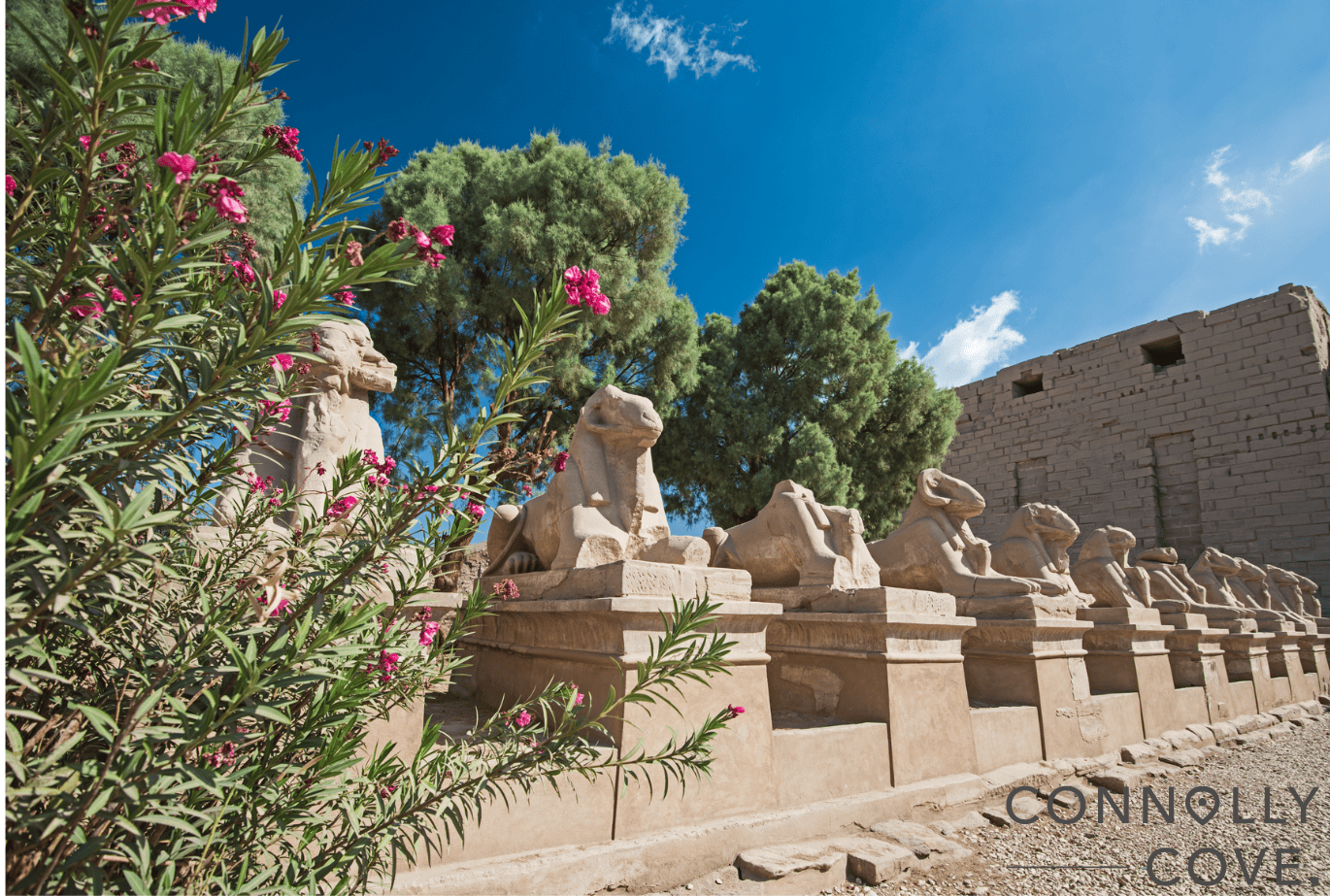
Updated On: February 19, 2024 by Noha Basiouny
On Thursday, 25 November 2021, in a huge televised ceremony no less spectacular or lavish than the Pharaohs’ Golden Parade, which took place in Cairo a few months earlier, Egypt reopened the Avenue of the Sphinxes in Luxor, or what used to be Thebes, to the public after many years of closure.
The renovation of this historic path, which happened over the course of four years, is part of a massive plan the government is undergoing to revive Egypt’s tourism and promote its invaluable attractions after it had been, like many others, struck by misfortune during the pandemic, which left the economy in a severe setback.
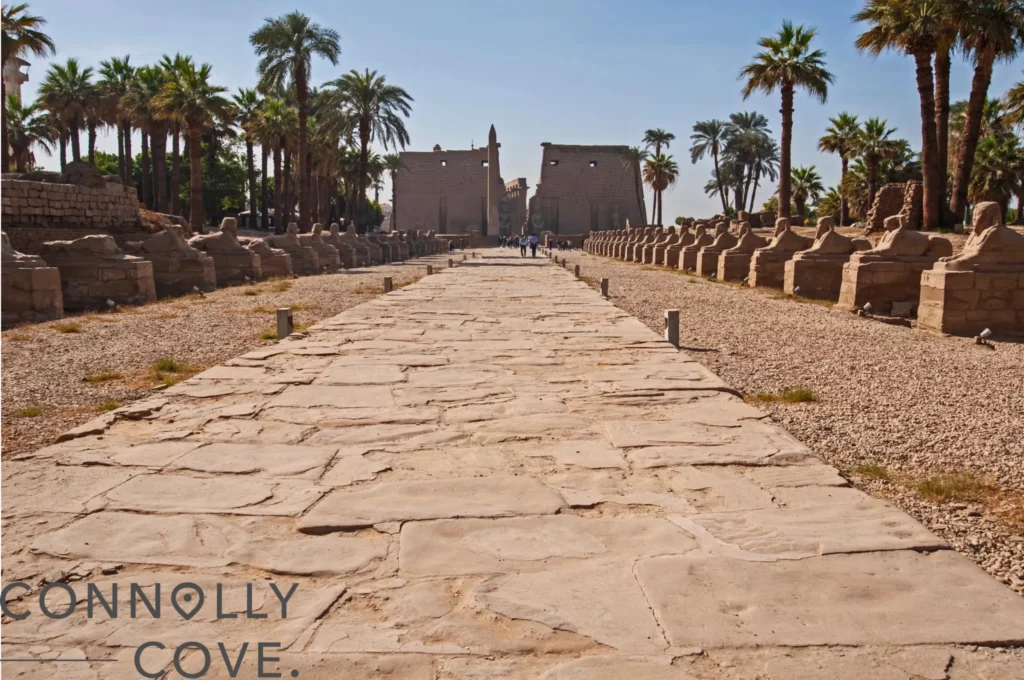
Originally comprising over 1500 statues spread, on each side, along a distance of almost three kilometres, the construction of the Avenue of the Sphinxes actually started in the New Kingdom of Egypt, which stretched from 1550 to 1069 BC and was completed sometime in the 5th century BC. For thousands of years, the Avenue had been buried under piles of sand until the first statue was unearthed in 1949.
The Avenue of the Sphinxes was extremely important in ancient Egypt and is a great asset of modern Egypt. Yet, not many people, unfortunately, seem to know a lot about it, which is precisely what we are uncovering in this article. So bring along a cup of coffee, and let’s go south to Luxor.
Luxor

During the Old Kingdom of Egypt (2687-2181 BC), the city of Memphis in Lower Egypt used to be the capital. But throughout the Middle and New Kingdoms, the country’s administration, and therefore the capital, moved to Upper Egypt, precisely to a small city called Thebes. Gradually, Thebes became the most profound political and religious centre and where most Pharaohs decided to live, invest in, and leave their legacy, especially when it came to building activities. It was also chosen to be the Pharaohs’ final resting place.
Interestingly, Thebes was not the name ancient Egyptians gave to their sacred city. Instead, they called it Waset, which, as Google told us—seriously, buddy, thank you very much—was derived from the name Wosret. Wosret, if you are wondering, was a goddess based and worshipped in Thebes, and her name meant ‘the powerful female one’. She was also the wife of Amun, who was at first the god of the air but evolved into the King of all deities later on. So, it makes sense to name the city after its goddess.
When the Greeks arrived in Egypt, they gave the city the name Thebes which is just the proper name of a city in Greece that was destroyed by Alexander the Great. When Egypt became an Arab Muslim country, the name Luxor, which means the Palaces in Arabic, was given to the city.
With an area of just 43 square kilometres, Luxor is nicknamed the world’s greatest open-air museum as it is home to hundreds of remarkable monuments and architectural masterpieces, from temples, chapels, roads, and shrines to thousands of royal tombs, obelisks, statues, and treasures.
Karnak Temple and the Luxor Temple are two of those masterpieces, and by far the most prominent, tremendous as well as fantastic attractions there are in all of Egypt, and whose visiting is just as essential as the security stamp anyone arriving in the country must obtain to be allowed in.
The Avenue of the Sphinxes happens to be the road that links these two temples to one another. So its significance is tied to these two places and what they were built and used for. In other words, to understand why the Avenue of the Sphinxes is such a big deal, we first need to look into the two famous temples.
Karnak Temple
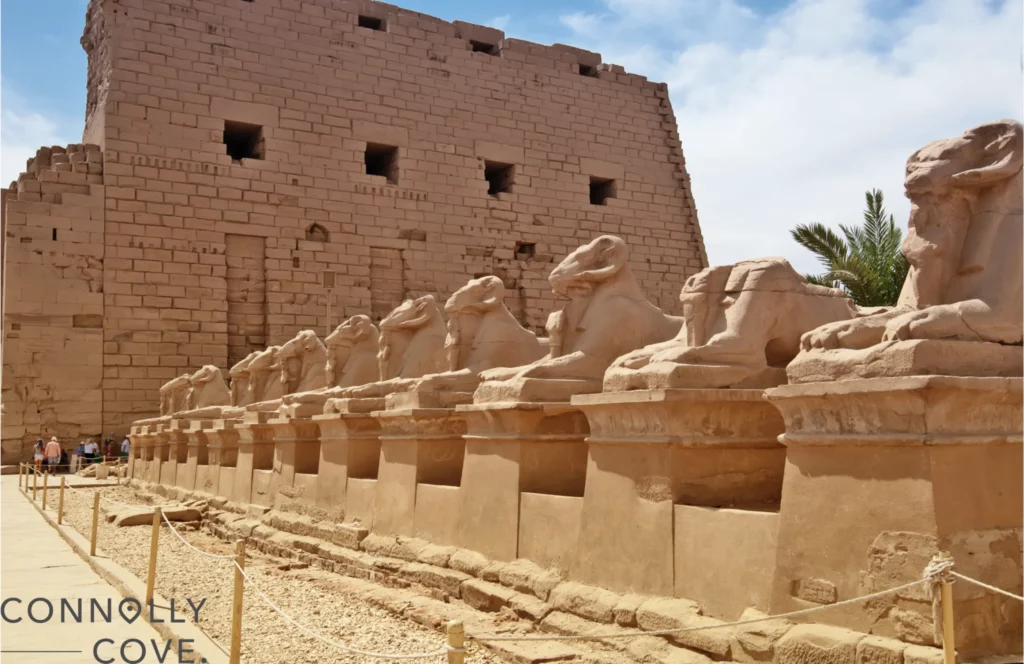
The Karnak Temple was initially built to worship Amun-Ra, the King of gods and the chief deity in the ancient Egyptian religion. With an area of 200 acres or 809,371 square metres, it is not actually one temple but rather a gigantic religious complex that comprises many other temples and walls and monuments. This pretty much made it the largest religious site in the world.
The construction of the Karnak Temple started in the Middle Kingdom of Egypt (2040 to 1782 BC) and continued until 100 AD. It was the most preferred place for every Pharaoh who wanted to document their achievements and leave their descendants a substantial legacy.
Instead of going elsewhere, many Pharaohs, such as Seti I, Ramesses II, Thutmose III, Ramesses III, and the mighty Queen Hatshepsut, built their temples, all of which were dedicated to the gods, at Karnak and expanded it even more.
One of the most terrific additions to the temple, for instance, is the Great Hypostyle Hall, built by Pharaoh Seti I. This is a 5,000-square-metre hall comprising 134 colossal sandstone columns made in the shape of papyrus stalks. The tallest of these columns is 24 metres, while the rest are 12 metres. They are decorated with carvings and raised reliefs of the King and the military achievements he made. So, they acted kind of like the King’s very own diary.
Another unique monument in Karnak Temple is the Obelisk of Queen Hatshepsut, who ruled during the 18th Dynasty, the first in the New Kingdom of Egypt. The Obelisk was made from a single piece of red granite with a height of almost 30 metres and weighing 343 tons. It was erected in the middle of the temple and has since been standing upright like a witness to the brilliance of ancient Egyptians and the greatness of their civilisation.
Luxor Temple

Not too far away from Karnak Temple, Luxor Temple, another magnificent complex, is located. The construction of the Luxor Temple started during the reign of Pharaoh Amenhotep III, the ninth to rule in the 18th Dynasty of the New Kingdom of Egypt. That was sometime between 1390 and 1358 BC. Like Karnak Temple, Luxor Temple was built over a long period of time, yet not as long as a millennia and a half! It was expanded by Kings Tutankhamun and Horemheb, the last two Pharaohs of the 18th Dynasty, as well as Ramesses II, the third king of the 19th Dynasty and the greatest of all time.
While most other temples were built for religious reasons and dedicated to the gods, there are two different theories for why Luxor Temple was built. Some scholars believe it was not devoted to Amun-Ra nor to any other of the 1,400 deities ancient Egyptians worshipped. Instead, it was constructed for the coronation of the new Pharaoh during the transition of power. So, it was the ancient Egyptians’ Westminster Abbey!
Another theory claims that this very temple was built and dedicated to Amun-Ra, the chief of all gods, his wife, Mut, and their son, Khonsu and was especially used to host the Opet Festival, which ancient Egyptians used to celebrate in summer every year during the Nile flooding season.
Speaking of the area, Luxor Temple is much more spacious. It also comprises a Hypostyle Hall of many, many columns arranged in a certain way and supporting a ceiling. The design and structure of the columns might be a little different from those at Karnak Temple, yet they are just as majestic.
Part of the development Ramesses II made to Luxor Temple was the addition of two giant obelisks, which came to be known as the Luxor Obelisks. Like those of Queen Hatshepsut, Luxor Obelisks were made from a single piece of red granite taken from a quarry in Aswan. The two obelisks were not made of the same height and were placed at the temple’s pylon, a little far from one another.
As of today, only the taller obelisk still stands in front of the temple, while the shorter one is now in Paris—I know!
Avenue of the Sphinxes
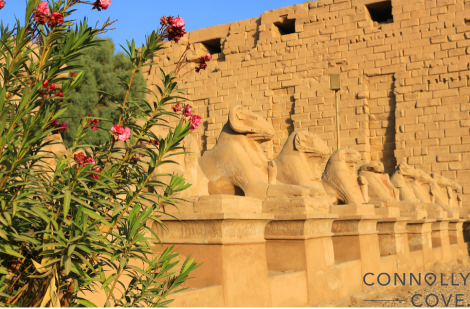
Now that we know about the two destinations it runs between, let’s explore the Avenue of the Sphinxes. So, the Avenue of the Sphinxes is also called the Road of King’s Festivities, the Path of God, or the Rams Road, which is a translation from the Arabic name Tareeq al-Kebash. Each name of these describes an aspect of the Avenue, as we will see in a bit. It is 76 metres wide and 2.7 kilometres long, which is equivalent to a 30-minute walk.
The construction of the Avenue of the Sphinxes started during the reign of Pharaoh Amenhotep III, and yes, he was the same royal who started Luxor Temple. Like with Luxor Temple, succeeding Pharaohs continued the development of the road until it was finally completed by Pharaoh Nectanebo I, the first of the 30th Dynasty (379-340 BC) and the third to last Pharaoh of Egypt.
On the right and left sides of this Avenue, there are human or ram-headed sphinxes, each sitting on their flanks on sandstone blocks with hand extended in the famous peaceful cat-seating position.
The total number of statues was estimated to be over 1500; however, around 1,057 were renovated and reopened in that spectacle Egypt hosted in Luxor in November 2021. Around 807 of these statues were of sphinxes, and 250 were ram-headed. It is believed the remaining ones have not yet been excavated.
Discovery
Despite its existence between the two temples for thousands of years, the sacred path was not actually discovered until the mid-20th century. Before that, there was only one indication of it in the Description of Egypt, or if you are feeling very fancy, La Description de l’Égypte. This is a huge 23-volume publication the savants Napoleon brought with him on his French campaign in Egypt produced. In this publication, they described, in detail, and based on their very own studying and observations, everything about Egypt’s history, geography, society, and religions.
Among the thousands of things they came across was the Avenue of the Sphinxes, but they only found 600 statues. Later on, in the late 19th century, a French Egyptologist reported there was no way to excavate the Avenue, for it was entirely buried under the sand. At the time, those powerful gigantic sand-removing machines were not even an idea yet, so the Avenue remained buried.
But it was not until 1949, when serious excavation of the site started, that Egyptian archaeologist Mohamed Zakaria Ghonaim discovered eight statues toward Luxor Temple. The discovery, the state of the statues and their lining up beside one another suggested that there were absolutely more. So, excavation work continued, and until 1964, 77 more statues were uncovered.
By the end of the century, the entire Avenue was uncovered and turned into a tourist attraction. But unfortunately, during the revolution of 25 January 2011, many statues were damaged. However, the Avenue was way too invaluable to be left behind unrenovated. So, in 2017, the Egyptian government underwent a brand new restoration project for the Avenue. In 2021, it was ready to welcome visitors again.
Statues
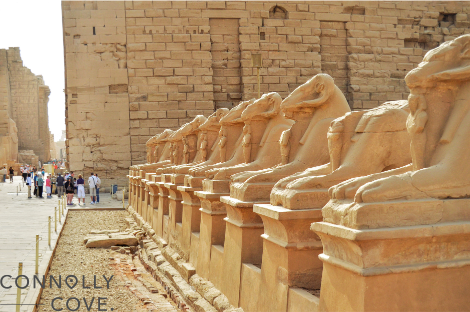
Interestingly, the restored 1,057 statues are not all alike. Instead, they are divided into three different groups, with each having a distinct shape. This is either a ram, a sphinx, or a ram-sphinx—a sphinx is usually a lion’s body with a human’s head, so a ram-sphinx has the head of a ram and the body of a lion.
Starting at Karnak Temple, the statues are of rams. These were the first to be built by Pharaoh Amenhotep III. After those, a group of other ram-sphinx sculptures along a trail of 305 metres were added by King Tutankhamun. The third group, comprising the largest number of statues and covering a much longer distance, has sphinx statues. These ones were apparently added by Pharaoh Ramesses II.
The Opet Festival
The significance of the Avenue of the Sphinxes comes from its being the path of god during the Opet Festival. Every summer, the Nile flooded, bringing rich silt deposits that fertilised the land and made life in Egypt possible. This land fertility was kind of a reflection of the fertility of Amun-Ra himself and the Pharaoh, who also turned into a deity after his death.
So to celebrate the fertility of Amun-Ra and the Pharaoh, ancient Egyptians held an annual ceremony called the Opet Festival that took place in the middle of the Nile flooding season. This typically happens around July and August every year.
The festival was initiated during the New Kingdom of Egypt (1550-1069 BC) and continued until the Late Period, toward the end of the native rule of Egypt. It usually lasted for 11 days and sometimes more if the Pharaoh wanted to. For instance, it used to continue for 22 days during the reign of Ramesses II, the third king of the 19th Dynasty.
So What Exactly Was This Festival Like?
Well, a lot of things happened. At first, a huge parade of priests carrying three lavish boats on which three statues of Amun-Ra, his wife, and their son moved from Karnak Temple, where the gods used to stay most of the year, to Luxor Temple, the actual festival venue, which somewhat also acted like their summer stay.
The priests would walk all the way on the Avenue of the Sphinxes, surrounded by the rams who secured the parade and the crowds who witnessed and cheered for the passage of the gods. In some years, the boats sailed in the Nile instead of being carried by the priests.
Once the parade arrived at Luxor Temple, celebrations would take place to symbolically rebirth the Pharaoh and ensure his fertility and his right, given to him by Amun-Ra himself, to rule the country.
That Is for the Gods and Royals but What About the Real People?
Well, they did have a blast too! The Opet Festival was a big occasion for ancient Egyptians to cook, eat and share food, indulge in drinks, sing, dance, and enjoy their time feeling blessed by the gods and taken care of by the Pharaoh.
After the festival ended, Amun-Ra and his family were carried back through the Avenue of the Sphinxes to Karnak Temple.
When the Romans conquered Egypt in 30 BC, they closed Luxor Temple, without which the festival was not held. Gradually, the Opet Festival disappeared, and for the next two thousand years, the wind carried the sand, and the Avenue of the Sphinxes, slowly and patiently, like a compound effect, ended up buried.
Reopening
Although the grand opening of the Avenue of the Sphinxes already took place in autumn, Egypt made a terrific replica of the summer Opet Festival with men dressed in Egyptian-style black and gold robes, resembling the priests, carrying three stunning ancient Egyptian golden boats dedicated to Amun-Ra and his family and walking down the Avenue with statues on the right and left sides beautifully lit. The ceremony was completed with an orchestra, terrific lighting effects, professional dances, and fireworks.
If you are making it to Luxor this year, try to organise a sightseeing tour starting from Karnak Temple, down the Avenue of the Sphinxes and all the way to Luxor Temple. This will guarantee you see three of the most magnificent highlights of Egyptian brilliance and fantastic civilisation.
But also make sure you visit some of the city’s other terrific attractions, on top of those, undoubtedly, are the Mortuary Temple of Hatshepsut, the Valley of the Kings and the Valley of the Queens, if you are really looking forward to a never-to-forget travel experience.






